If you’re planning a Black Hills road trip, there are plenty of things to do near Mount Rushmore besides seeing the iconic presidential monument.
My husband Daniel and I visited the Black Hills in the summer of 2020 and were blown away by the natural beauty of the area. There are several state and national parks nearby that provide a great introduction to the beautiful Black Hills.
In fact, visiting Mount Rushmore ended up being the least interesting part of our Black Hills road trip.
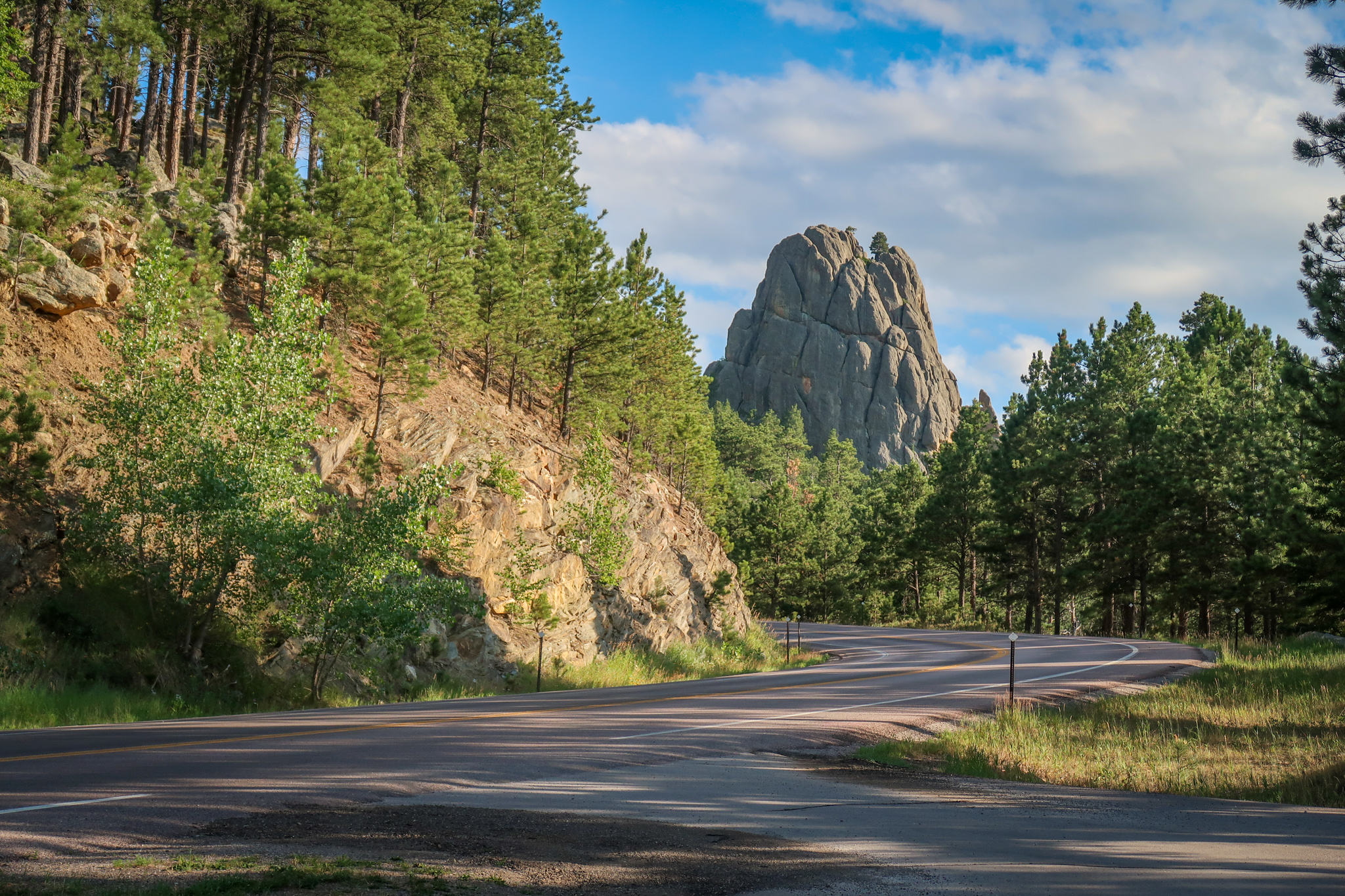
Driving through the Black Hills National Forest towards Mt. Rushmore
Table of Contents
Black Hills Road Trip Itinerary
I hadn’t really known what to expect when we planned our visit to the Black Hills. We initially only booked a couple of nights at a local campground, but two nights turned into three when we ran out of time to see everything. The Black Hills surprised me at every turn with their rugged beauty and the diversity of things to see and do.
We would have stayed even longer, in fact, but the area was getting increasingly overrun with motorcycles. Our visit happened to take place a few weeks before the annual Sturgis Motorcycle Rally and the whole region is was gearing up for it. We wanted to be far away from the Black Hills when that happened.
Here’s a suggested itinerary of things to see during a Black Hills road trip:
- Black Hills National Forest
- Wind Cave National Park
- Crazy Horse Monument
- Custer State Park Wildlife Loop
- Mount Rushmore
- Dinosaur Park
- Devil’s Tower (Bear’s Lodge)
Black Hills National Forest
Located in western South Dakota and northeastern Wyoming, the Black Hills National Forest spans an area of over 1.25 million acres. Described as an “Island in the Plains,” these majestic mountains rise from adjacent grasslands into a Ponderosa Pine forest. While not technically part of the Black Hills National Forest, Mount Rushmore is located in the middle of it – so any visitor to the presidential monument will have the pleasure of seeing the National Forest for themselves.
With over 450 miles of hiking trails and 11 reservoirs that are stocked for sport fishing, there are many opportunities for outdoor recreation in the area. The 22-mile Spearfish Canyon Scenic Byway is a popular drive in the area and a great way to see the Black Hills National Forest. During my visit to Mount Rushmore, we drove along Highway 244 through the heart of the forest and stopped by Horse Thief Lake to admire the scenery.

Rugged beauty of the Black Hills in Black Hills National Forest
Beginning our Black Hills Road Trip: Wind Cave National Park
I’m on a quest to visit every National Park, so our first stop on our Black Hills road trip was to Wind Cave National Park. One of the nation’s oldest National Parks, Wind Cave is home to one of the longest caves in the world. The cave has an extensive network of calcite formations called boxwork which are supposed to be pretty spectacular.

Welcome to Wind Cave National Park!

An opening to Wind Cave. The cave is a sacred site to the Lakota People in their oral creation story.

Mixed grass prairie
Sadly, we weren’t able able to visit the cave as the elevator has been out of service for over a year. And even if the elevator was operational, we still probably wouldn’t have toured the cave since we visited during the pandemic. It’s hard to maintain social distancing in a cave.
So we contented ourselves with an exploration of the park’s scenery above ground. Wind Cave boasts the largest natural mixed-grass prairie in the United States and is home to bison, mule deer and prairie dogs. Lots and lots of prairie dogs. In fact, we saw all three of these animals during our short drive through the park. But mostly prairie dogs.

What’s up, prairie dogs?
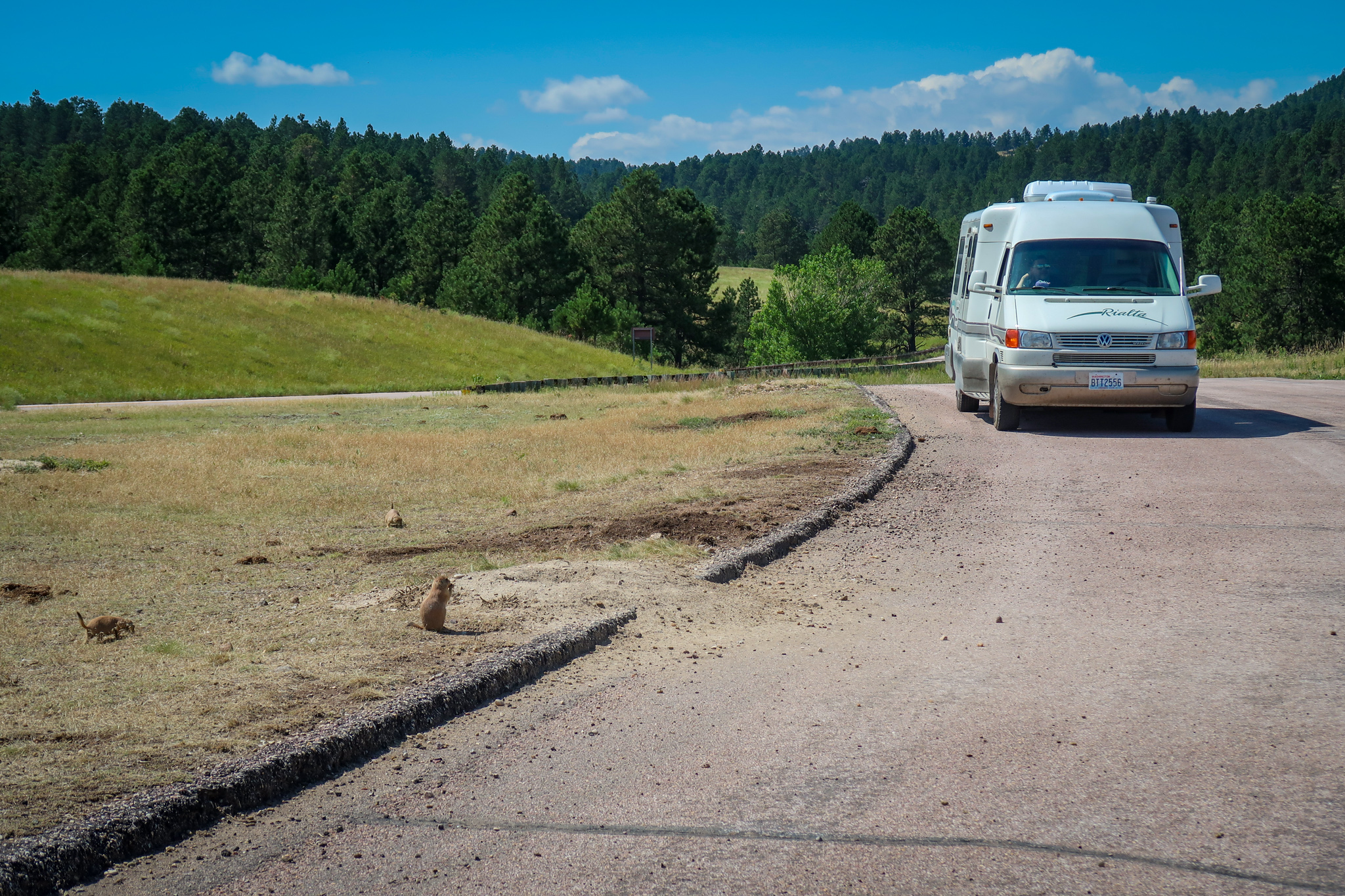
These guys decided to make their homes right next to the parking lot. It was very convenient for picture-taking.

Prairie dog close-up. Photo courtesy of Daniel and his telephoto lens.
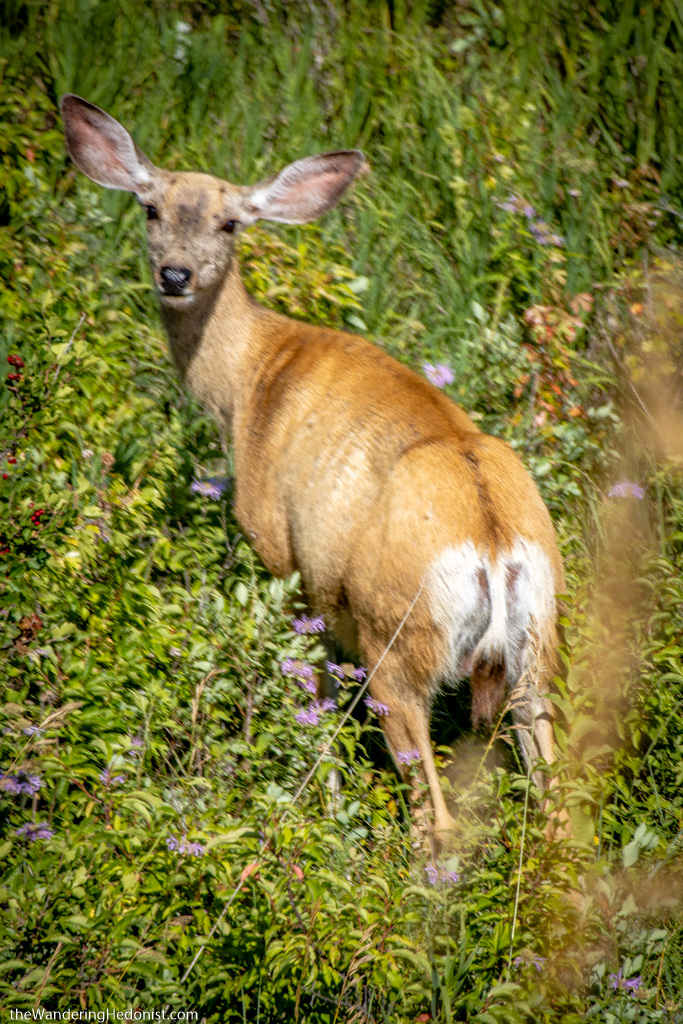
Mule deer. Photo by Daniel.
Crazy Horse Monument: A Must-See on any Black Hills Road Trip
After stopping by Wind Cave, Daniel and I continued our Black Hills road trip with a visit to the Crazy Horse Monument. This partially-finished structure is a massive sculpture of the revered Lakota leader. Crazy Horse, of course, was made famous as one of the leaders in the Battle of Little Bighorn.
The Crazy Horse Memorial has been in construction since 1948 and will eventually be the second-tallest statue in the world. Right now only the face of the sculpture is finished.
The sculptor, Korczak Ziolkowski, envisioned the monument as a metaphoric tribute to the spirit of Crazy Horse who reportedly said, “My lands are where my dead lie buried.” This is why Crazy Horse will be pointing with his arm outstretched to the Black Hills when the monument is completed.

Crazy Horse Monument. The final dimensions are planned to be 641 feet long by 563 feet tall.
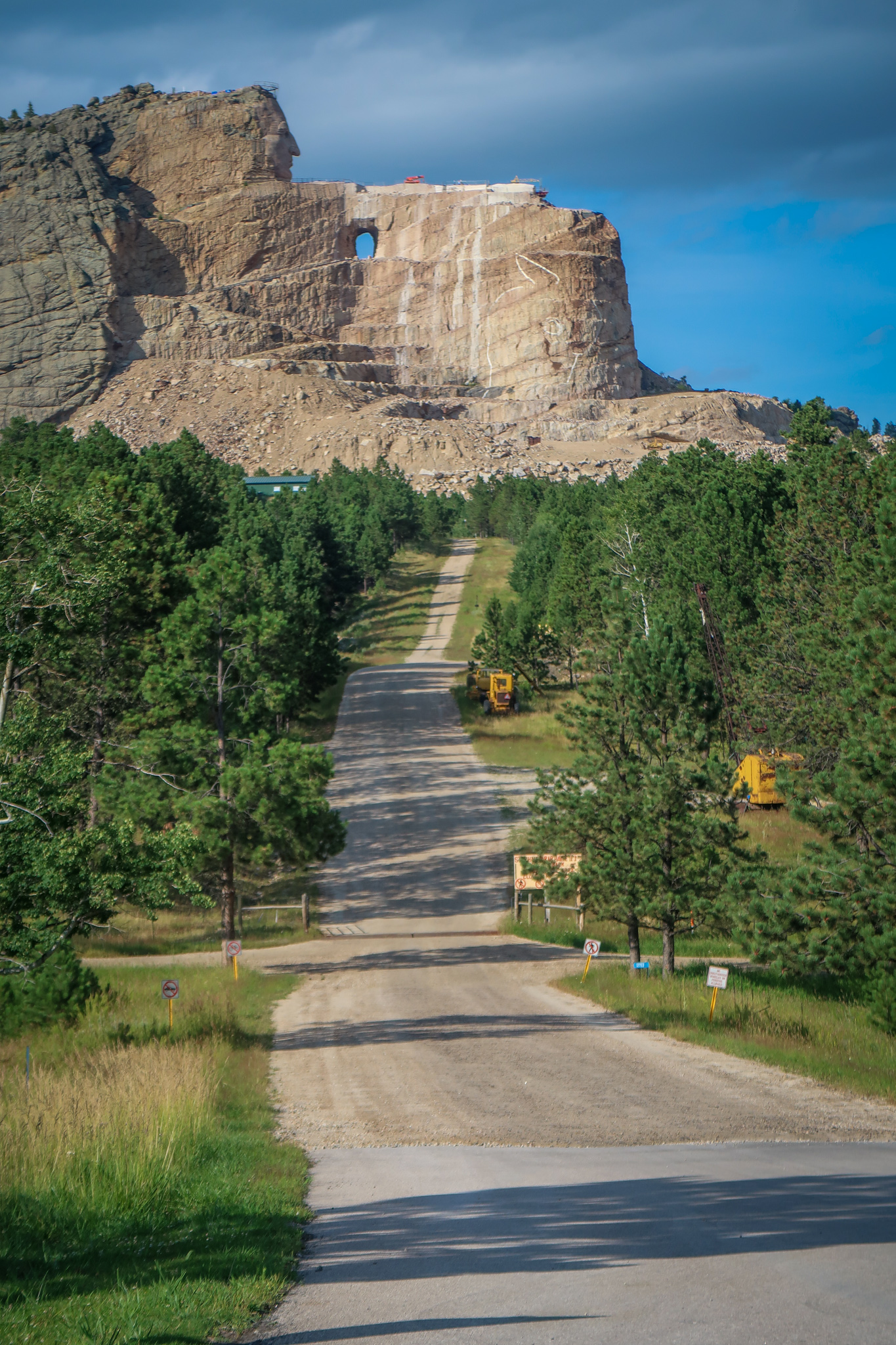
The road leading up to the monument. Buses take visitors to the base of the monument for a closer look but we skipped this part of the tour.

Scale model of what the sculpture will look like when completed. You can see the partially finished monument in the background.
Mount Rushmore
After visiting Crazy Horse, we continued north towards Mount Rushmore. I planned for our visit to take place in the evening in the hopes of avoiding the crowds. We arrived at 6:30 pm on a Sunday evening and had no such luck. The place was packed with people and there was really no room to spread out.
Maybe if we arrived later in the evening it would have been more manageable. During our visit, however, it was not possible to maintain a reasonable social distance. We debated leaving, but in the end, decided to continue with our visit as planned. We put on masks, dashed in, snapped a few photos, and dashed back out a few minutes later.

Mount Rushmore! Now I can cross this off my bucket list.
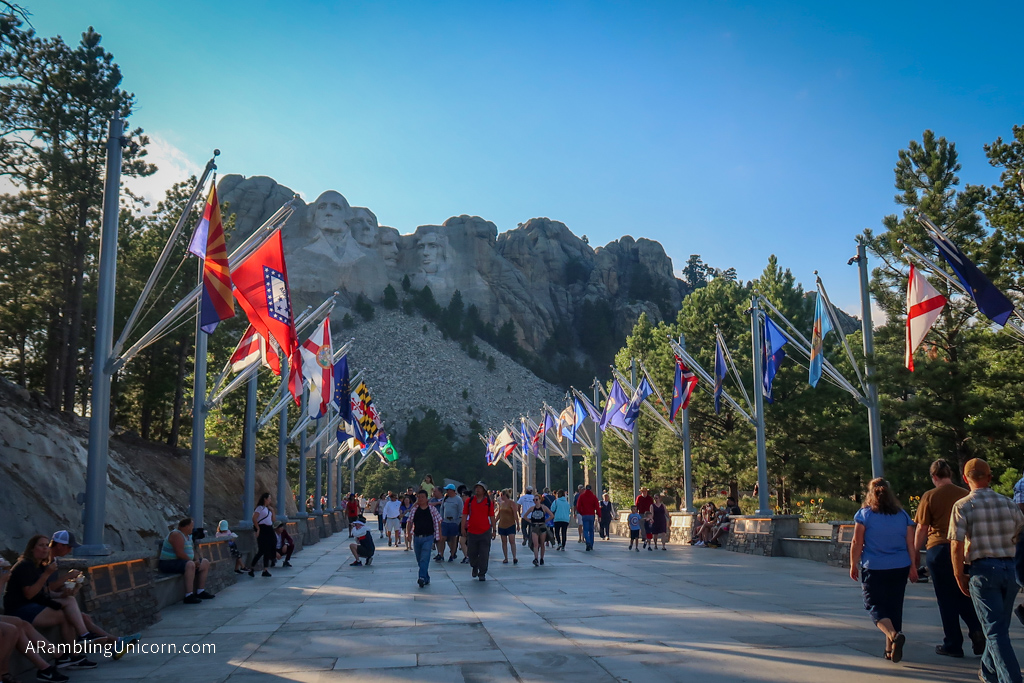
The flags of all 50 states line the pathway approaching Mount Rushmore

Obligatory Mount Rushmore selfie
Daniel and I had a better experience viewing Mt. Rushmore as we drove away. We stopped in a scenic pullout along Highway 244 and found a great view of the monument in profile. True, we could only see Washington’s face, but that was fine by me. We also had a lovely view of the Black Hills from here which I’d rather see anyway. And there were no other people.
Perfect.

Washington in profile

Your Rialta photo for the day
Now I had some space to reflect on Mt. Rushmore and its complicated history. I recently became aware of the controversy surrounding the Black Hills when President Trump visited the area over the Fourth of July weekend. As reported in this ABC News article, Mt. Rushmore is “a reminder to Native Americans of the countless treaties broken by the U.S. Government”.
The Black Hills were promised to the Sioux tribe in the 1868 Fort Laramie Treaty. The Black Hills area has been considered sacred to the Lakota and other native peoples for thousands of years. However, when Custer discovered gold in the region, everything changed. The tribes were pressured into selling the land in a transaction that was later deemed illegal by the United States Supreme Court.
So I have mixed feelings about being here. This is why I prefer to view Mount Rushmore National Monument away from the crowds. Here, the monument is separated from patriotic pomp and flag-waving. It is easier to view the sculpture in context of the natural beauty of the Black Hills. And I have space to consider this piece of our nation’s history as well as its complicated past.
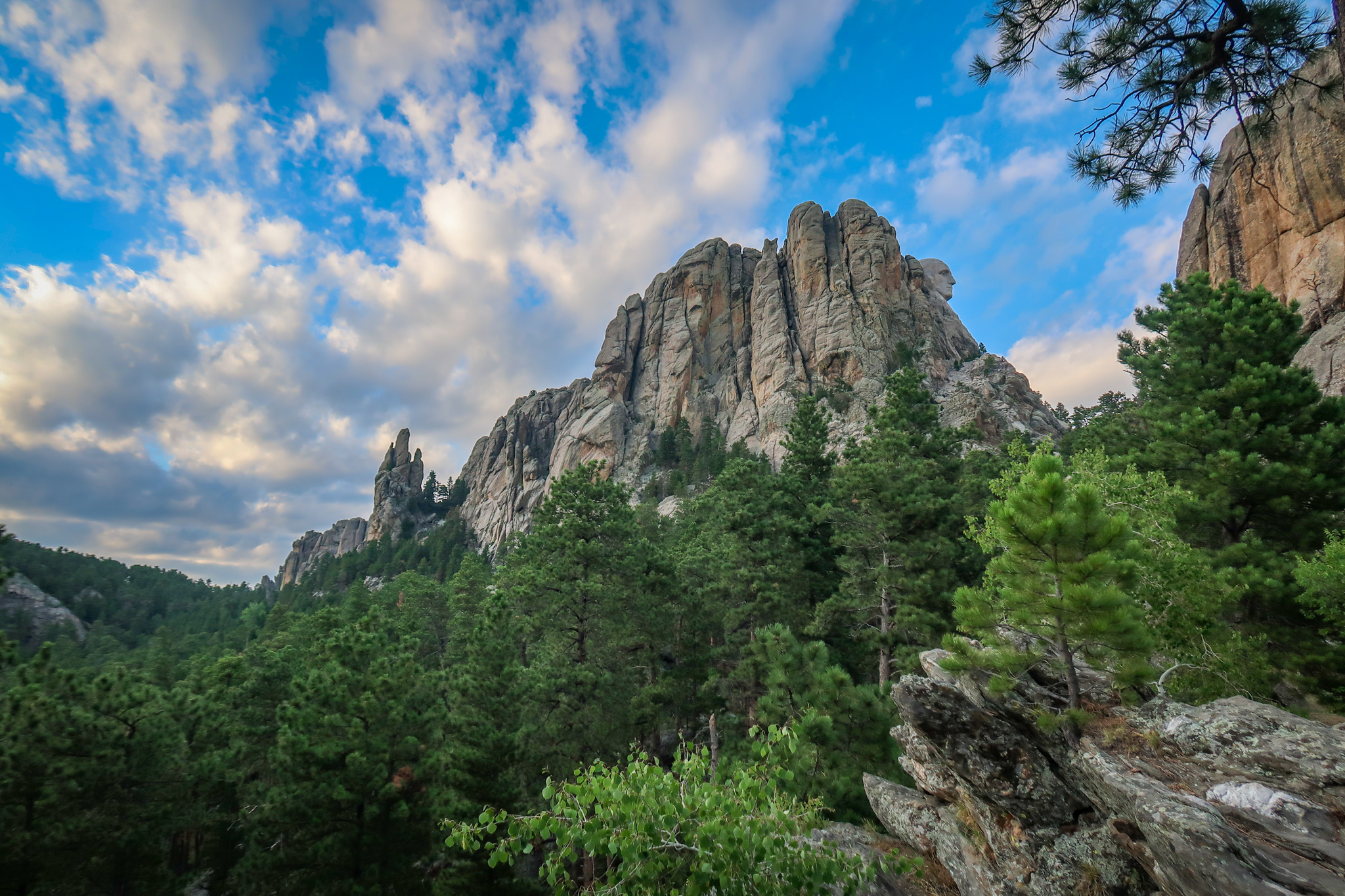
The beautiful Black Hills. Mount Rushmore in profile is visible in the upper right-hand corner.
Custer State Park Wildlife Loop
Another popular attraction in the area is Custer State Park. One of the nation’s largest state parks, Custer State Park is famous for its scenic drives and wildlife. The park is home to over 1,500 bison as well as pronghorn antelope, elk, bighorn sheep, mountain goats, wild burros and more.
Daniel and I set aside a few hours to drive through the famous Custer State Park Wildlife Loop and really enjoyed it. In hindsight, we ended up feeling rushed and should have planned more time for this adventure.
For more details about visiting Custer State Park, check out my article on the Custer State Park Wildlife Loop.
Concluding our Black Hills Road Trip: Dinosaur Park
To conclude our Black Hills road trip, Daniel and I exited the area through Rapid City towards the Badlands. While we were there, we drove to the top of a ridge overlooking the town. This is where we found Dinosaur Park, a slightly cheesy tourist attraction which features a collection of dinosaur sculptures overlooking the town. Did I mention that it’s free? You can’t beat free!
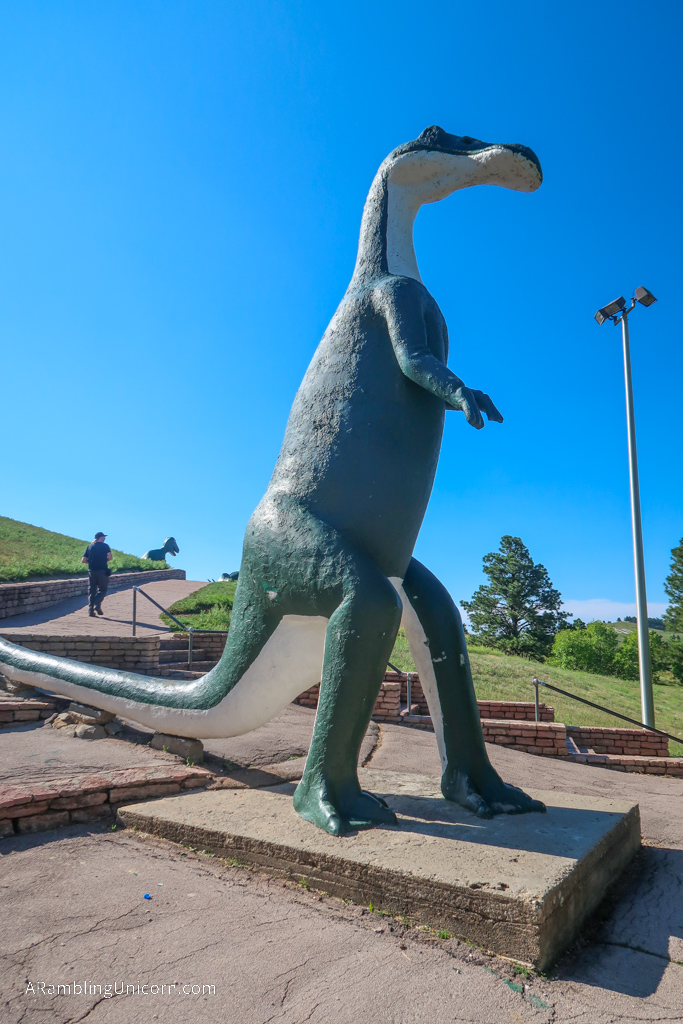
Welcome to Dinosaur Park
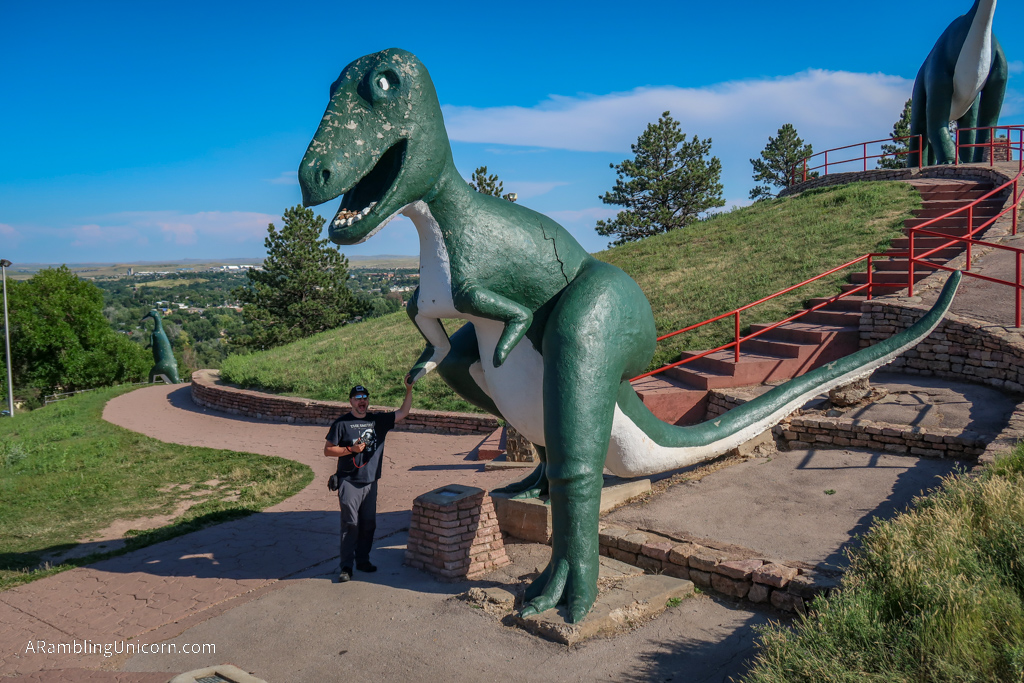
Daniel made a new friend

Dino fight!
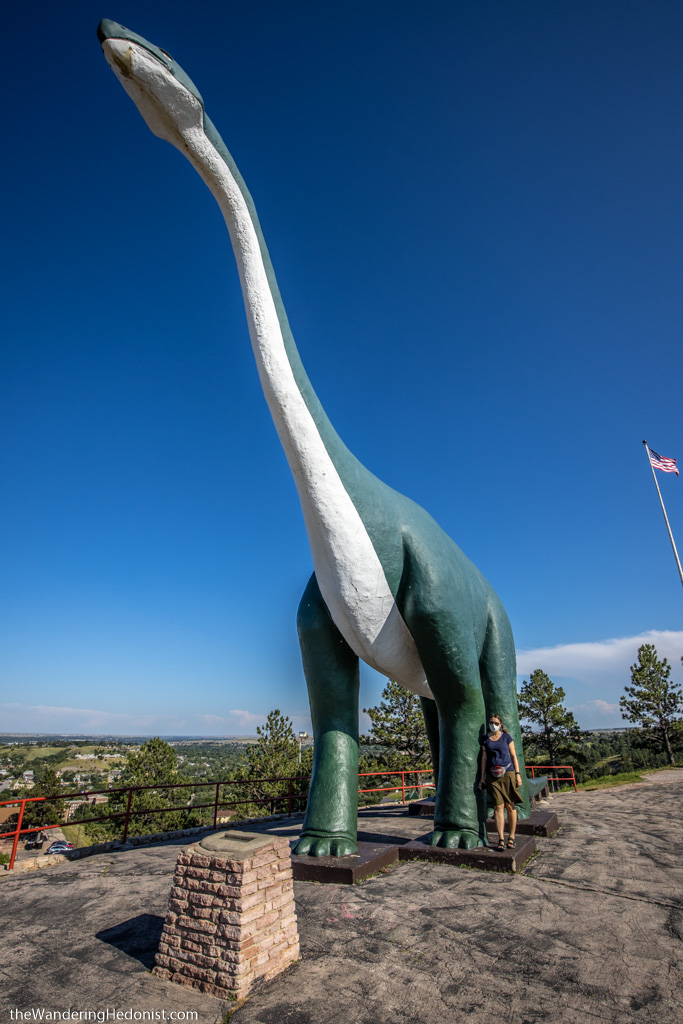
That’s one big dinosaur
Devil’s Tower (Bear’s Lodge)
While not technically in the Black Hills, Devil’s Tower (also called Bear’s Lodge) is another popular attraction in the area and definitely worth a visit. Located only 2 hours drive away, Bear’s Lodge is a spectacular geologic formation and is held sacred by many Native American tribes. My first introduction to Bear’s Lodge was in the film Close Encounters of the Third Kind and I’ve wanted to see it myself in person ever since.
More information about visiting Devil’s Tower is available in the following article: Devil’s Tower (Bear’s Lodge).
Black Hills Road Trip Accommodation: Big Pine Campground
Daniel and I booked a campsite at the privately-owned Big Pine Campground for our visit due to it’s central location near all the things that we wanted to see in the Black Hills. The campground has a number of 30 and 50 amp sites nestled among the forest along with some primitive tent camping sites and a camp store. It was a great choice and we enjoyed our time there.
We even got to witness a spectacular thunder storm during our stay. Daniel and I were camped for the night and had already put our windshield covers in place. The best view of the lightening, however, was from the driver’s and passenger’s seats. So we crawled into the front and removed the window covers to enjoy the show. It was our first major thunderstorm since starting on our road trip and we were thrilled. We don’t typically have thunderstorms like this in our corner of the Pacific Northwest.
Where are we now?

We are at Mt. Rushmore! You can see Washington’s head in profile just above Daniel.
Dates: August 2-3, 2020
Great American Road Trip Status: Days 28 & 29
Location: Big Pine Campground, SD
Miles Traveled: 90.7
Total Trip Mileage: 2942.2
For more details on our Great America (Socially Distanced) Road Trip, see my previous posts:
- Day 27: Joyner Ridge and Red Beds Trails
- Day 26: Bear’s Lodge (Devil’s Tower)
- Days 22-25: The Middle of Nowhere
- Day 21: Wildlife Fiesta
- Day 20: Sunset at Grand Prismatic Spring
Like this article? Pin it!


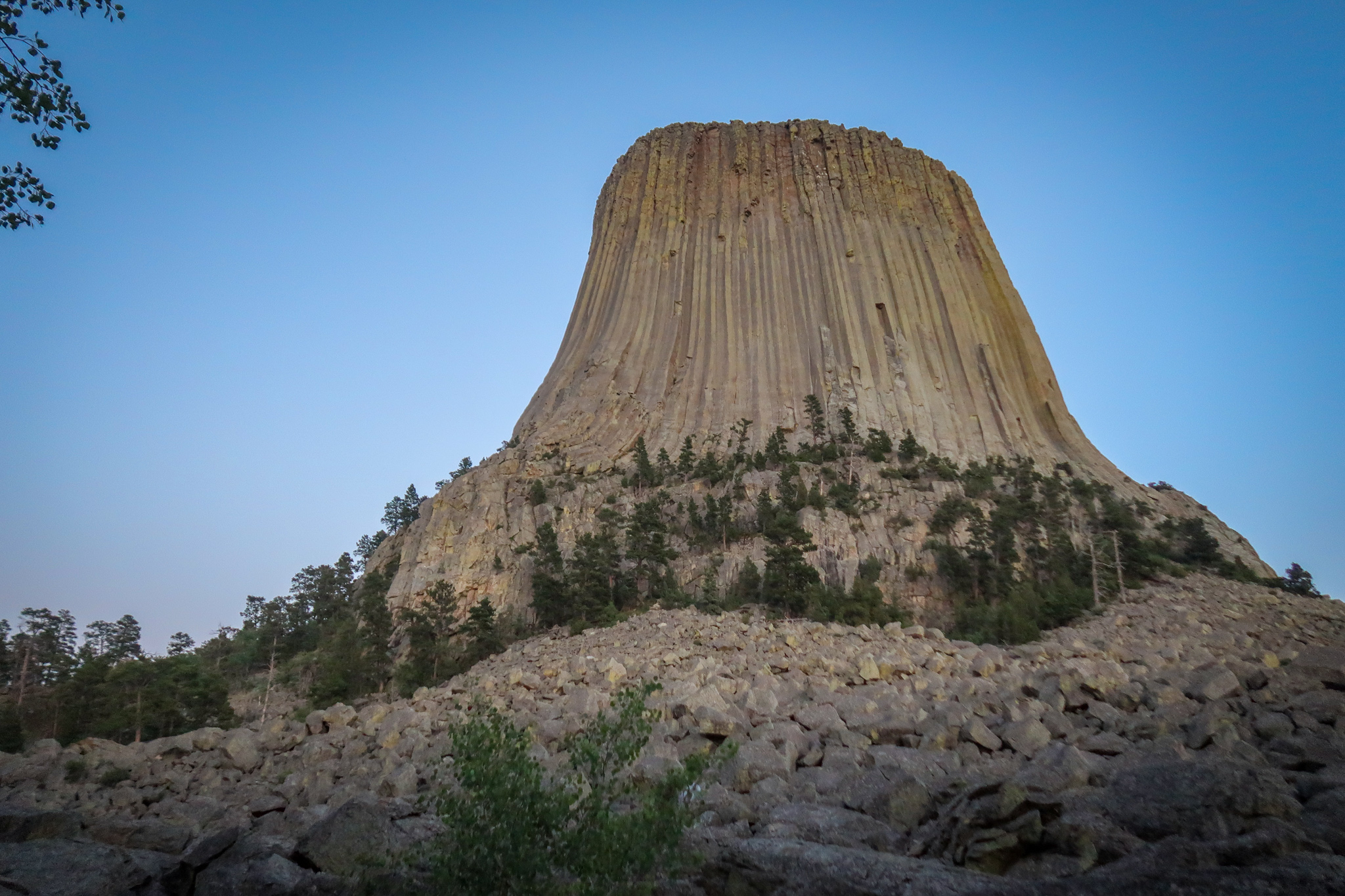

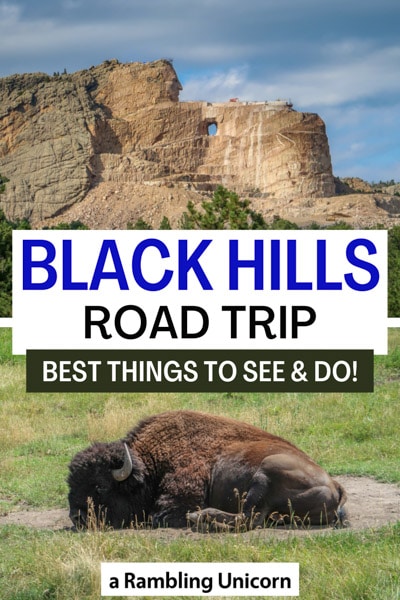
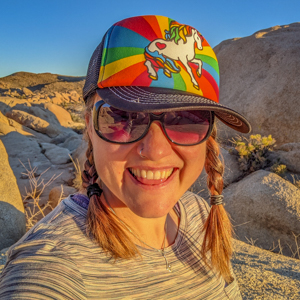
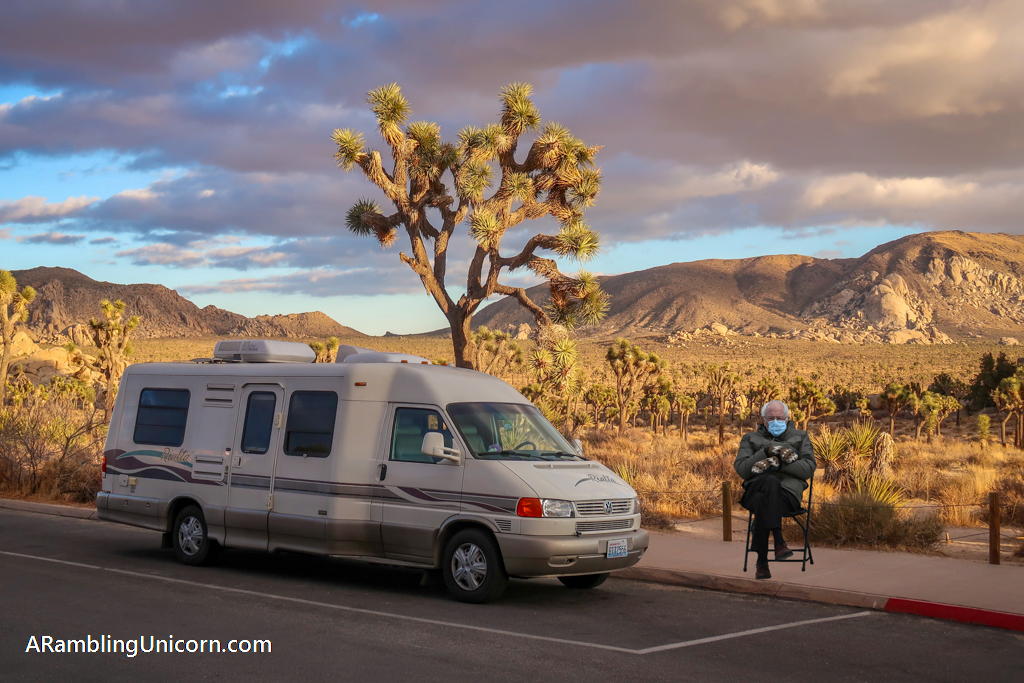
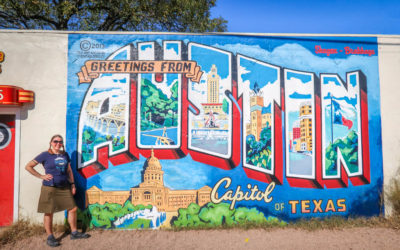


I’ve a photo of Crazy Horse Monument taken in 2004 – not much changed 🙂
They don’t seem to be moving very fast 😛